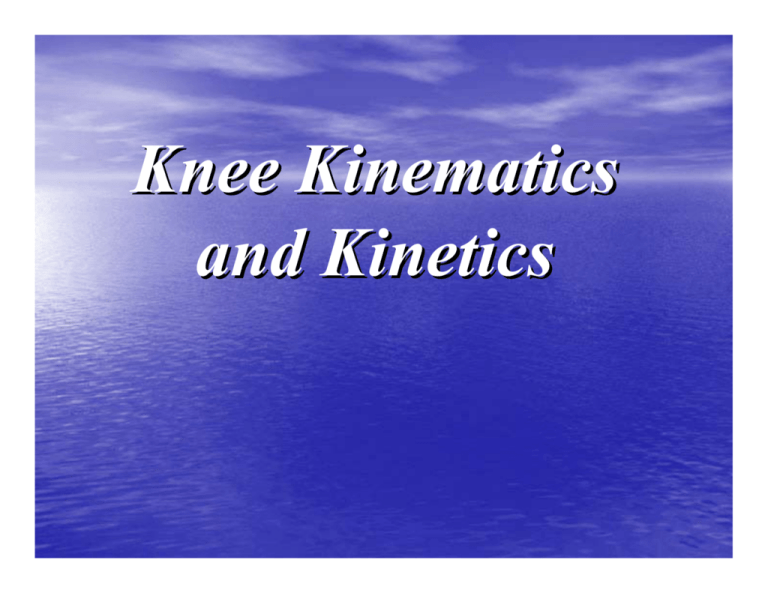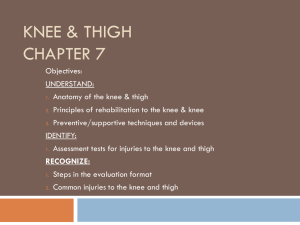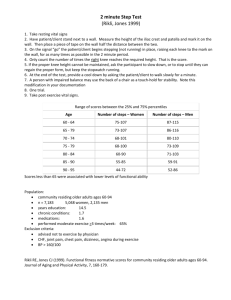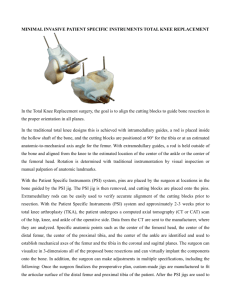Knee Kinematics
advertisement

Knee Kinematics and Kinetics Definitions: • Kinematics is the study of movement without reference to forces http://www.cogsci.princeton.edu/cgi-bin/webwn2.0?stage=1&word=kinematics • Kinetics is the study of movement with reference to forces The Knee: The largest and most complex joint structure • Transmit Loads • Participate in motion • Aids conservation of momentum • Provides a force couple for body activities Anatomy of the knee • 3 Bones – Tibia, Femur, Patella • 3 Compartments – Medial, Lateral, Patellofemoral • 4 Ligaments – MCL, LCL, ACL, PCL • 2 Menisci • Articular Cartilage The Knee Joint Peculiar Anatomy • Menisci – Fibro-cartilage support • Internal ligaments – Carry loads during motion Two menisci • Outer - lateral meniscus – – – Circular shaped , smaller ,more mobile Attached to the ACL Attached to the femur via the ligament of Wrisberg • Inner - medial meniscus – – – – “C” shaped wider posterior than lateral attached to the MCL attached to the joint capsule Menisci Menisci Functions • Deepen the articulation – Increase area of contact • Shock absorption – X10 BW • a skier lands from a jump • Increase stability – Cups the femoral condyle • Nutrition of cartilage – Sweeping synovial fluid across joint Range of Motion • Need to define planes • in which the particular motion is taking place The knee moves in six different directions of motions (6DOF) – Sagittal plane (0-1400) Tibia-femoral motion in the sagittal plane Activity Walking Climbing stairs Descending stairs Sitting down Tying a shoe Squatting Knee Flexion (degrees) 67 83 90 83-110 106 130 Tibio-femoral motion in the Transverse plane • Influenced by knee position in sagittal plane – Ex. If knee is in full extension rotation is restricted by interlocking of condyes with tibia • Rotation increases as the knee is flexed – maximum 900 flexion • External 450 • Internal 300 • Beyond 900 – decreases, due to soft tissue restriction Tibia-femoral motion in the frontal plane • Abduction and Adduction is also affected by the amount of knee flexion – Ex. Full extension precludes motion • Increased passive abduction and adduction occurs with knee flexion < 300 Locating an ICR • Successive films taken 100 intervals of flexion (A,B) • Tibia is parallel to the x-ray to prevent rotation • Marking two identifiable points on femur, and join these • points and draw perpendicular bisector (B) The intersection point of the perpendicular bisectors is the instant center of rotation. Joint Contact Points in Flexion • Two contact points – @ femur & tibia ¾ Medial • Translates slightly anterior on tibia ¾ Lateral • Translates considerably posterior on tibia Surface Joint Motion Types of motion at knee joint • Rolling Motion – Initiates flexion • Gliding Motion – Occurs at end of flexion Rolling Motion Gliding Motion Instantaneous Center of Rotation ICR • "If one rigid body rotates about another rigid • body, its motion at any instant can be described by a point or axis of rotation called the instantaneous center of rotation.“ For normal knees – Pathway of ICR is semicircular – Located on the femoral condyles ICR (cont’d) Joint Contact Forces • Ideally… we would have equal distribution of forces w/o any varus or valgus stresses Figure from Burstein and Wright, 1994 Joint Contact Forces in the knee Joint Contact Forces in the knee (cont’d) • During varus stress – To balance the stress • LCL tension rises • Knee shifts 5° varus • Increased stress on medial condyle – Repeated cycles of varus / valgus loading • Varus / valgus deformity • Cartilage wear Patello-femoral Joint Patellar Kinematics • Patella directly contacts femoral condyles in flexion • Patella acts as the fulcrum • It is said to be “lateral side dominant” – Greater surface area of contact on the lateral side as opposed to the medial Patellar Kinematics --Figure from Fulkerson, Disorders … 1997 3rd ed. Compressive Forces of Patella Figure from Fulkerson 1997 Patellar Kinematics • There are predictable areas of contact between patella and femoral condyles that change with degree of flexion: --figure from Fulkerson 1997 Patellar Kinematics 2 Forces acting on the Patella: • Laterally- lateral retinaculum, vastus lateralis m., iliotibial tract • Medially- medial retinaculum and vastus medialis m. • Superior- Quadriceps via quadriceps tendon • Inferior- Patellar tendon Patellar Kinematics 3 Figure from Fulkerson, 1997 Patellar Kinematics 4 • Sum of forces acting in the four directions – Determine movement pattern of the knee joint • Additional forces considered are: – Friction forces, compressive forces, torques, translational forces and internal stabilizing forces from soft tissues Patellar Kinematics 5 Q-angle : • Angle formed at the knee joint – By connecting a line from the anterior superior iliac crest to the center of the patella – And a second line from the center of the patella to the center of the patellar tendon insertion into the tibial tubercle Q-Angle Q-Angle (cont’d) Q-angle of 12 to 15 degrees is considered normal; while patients with patellar subluxation may have a Q-angle as high as 30 degrees Henry J.H., Goletz T.H., and Williamson B. “Lateral Retinacular Release in Patellofemoral Subluxation.” Am J of Sports Med. Vol. 14 No.2 1986 pp121129. Patellar malalignment • Generally associated with tightness of – Lateral retinaculum – Hamstrings – Iliotibial band – Quadriceps – Hip rotators – Achilles tendon Knee Kinematics The "Screw-Home” mechanism • Rotation between the tibia and femur – Occurs automatically between full extension 0o and 20o of knee flexion • SHM is considered a key element to knee stability for standing upright “Screw-Home” mechanism • Tibia – Internal rotation during the swing phase – External rotation during the stance phase • External rotation – Occurs during the terminal degrees of knee extension • Difference in radius of curvature of the medial and smaller lateral condyle – Results in tightening of both cruciate ligaments • Locks the knee • Tibia is in the position of maximal stability with respect to the femur Ligament Attachments in the knee Joint “Screw-Home” mechanism 2 • During Knee extension – Tibia rolls anteriorly, PCL elongates – PCL's pull on tibia causes it to glide anteriorly on femur Axial View of the Knee of Right Leg “Screw-Home” mechanism 3 • During the last 200 of knee extension – Anterior tibial glide persists on the tibia's medial condyle • Because its articular surface is longer in that dimension than the lateral condyle‘s “Screw-Home” mechanism 4 • Prolonged anterior glide on the medial side – Produces external tibia rotation – The "screw-home" mechanism “Screw-Home” mechanism 5 • When the knee begins to flex from a position of full extension – Tibia rolls posterior, elongating ACL – ACL's pull on tibia causes it to glide posterior – Glide begins first on the longer medial condyle “Screw-Home” mechanism 6 • Between 00 extension and 200 flexion – Posterior glide on the medial side produces • Relative tibial internal • rotation A reversal of the screwhome mechanism Internal Tibial Rotation New flexion and extension axis theory • A fixed flexion and extension axis theory [based on 3-D observation of knee] • Replacing the classic concept of the variable flexion and extension theory [based on observation in the sagittal plane] Flexion-Extension Kinematics • ”it has recently been shown that the F-E axis of the knee is FIXED within the femur and that the articular surfaces of the condyles are circular in profile” (Hollister et al. 1994, Hollerbach and Hollister, 1995) Flexion-Extension Kinematics Kinematics in Osteoarthrosis THE END







